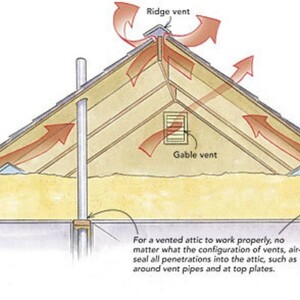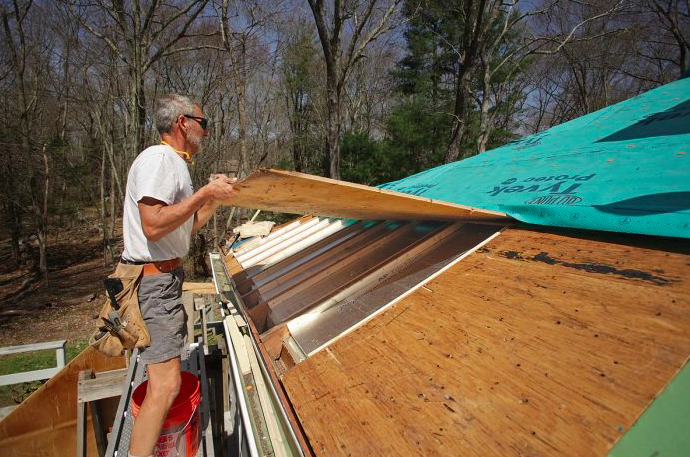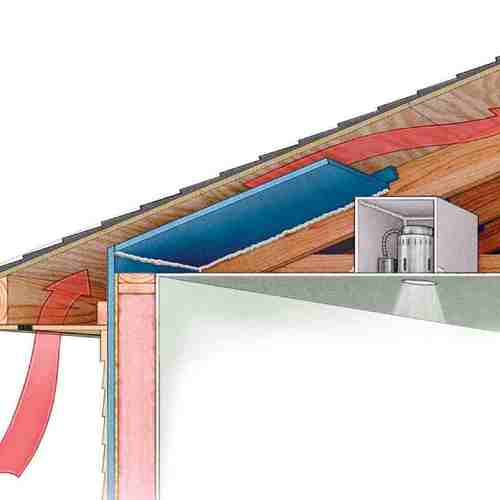
Most attics are vented, although some attics are unvented and conditioned. Cathedral ceilings can be vented or unvented—and either approach can work, as long as the details are right. Because of the wide range of possible venting scenarios, designers and builders are sometimes unsure of how to vent their roofs.
In a recent episode of the “BS + Beer” show, participants posted lots of venting questions on the chat forum. In this article, I’ll do my best to answer some of the questions.
Readers who are looking for a comprehensive article on attic ventilation should read “All About Attic Venting.” Those who are looking for a comprehensive article on venting cathedral ceilings should read “How to Build an Insulated Cathedral Ceiling.”
Q. I want to build an unvented roof assembly that includes continuous rigid foam above the roof sheathing. Do I need to create vent channels between the rigid foam and the roofing?
A. No. In most cases, you’ll install a layer of OSB or plywood roof sheathing above the rigid foam, fastening the sheathing to the rafters below with long screws. Above this roof sheathing, you’ll install roofing underlayment and roofing. Building codes don’t require this type of assembly to have vent channels. For detailed instruction on this approach, see “How to Install Rigid Foam On Top of Roof Sheathing.”
That said, note that some asphalt shingle manufacturers don’t allow their products to be installed on an unvented assembly. If this concerns you, choose a different brand of shingles or a different type of roofing.
While vent channels aren’t required above a continuous layer of rigid foam, they may make sense in areas of the country with lots of snow. Vent channels under roofing reduce the chance of ice dams—so if you’re building near…
Weekly Newsletter
Get building science and energy efficiency advice, plus special offers, in your inbox.

This article is only available to GBA Prime Members
Sign up for a free trial and get instant access to this article as well as GBA’s complete library of premium articles and construction details.
Start Free TrialAlready a member? Log in















19 Comments
This is somewhat related but I have a detached garage with cathedral ceiling. I'm going to build a floor on top of my ceiling joists so I can create a storage area on top and then insulate the floor instead of the roof. The attic will only be used to store what most likely will end up being junk I refuse to throw out. The detached garage compared to the home has always been harder to keep animals and pests away. A reader mentioned using semi rigid mineral wool for insulation, are animals more attracted to the exterior foam or mineral wool. My understanding that in terms of exterior foam, mineral wool is not as popular with pests as external foam. I also read somewhere that mineral wool can be left exposed because it is fire resistant? For those insulating their attic either in home or detached building are they better off using mineral wool to avoid a pest problem in their attic? Basically what insulation and materials is best to avoid animals and pests. I have had several battles with squirrels in the garage, recently I sealed up everything on outside and haven't seen them. Don't want to give them an invitation to come visit again though.
Hammer,
I'm not sure what you mean by "exterior foam" in this context. Do you mean rigid foam--something like EPS or polyiso? If you are insulating your garage ceiling, it won't really be exterior insulation; it will be cavity insulation.
In my experience, the most problematic insulation material for critter infestations is fiberglass batts, which rodents love. So I would think that mineral wool would be a better choice than fiberglass. For what it's worth, here at GBA we've heard reports that birds sometimes nest in mineral wool batts, and ants like to chew through EPS, especially if it is damp.
All of that said, the most important measure for keeping mice or squirrels out of your insulation (and out of your buildings) is to adopt airtight construction methods. Focus on air sealing--really focus on the details--and verify your work with a blower door. That's the best way to keep critters out of your building.
Martin
Thanks for the advice and yes I was talking about eps when I was referring to exterior foam. Based on what you were saying I will use mineral batts as insulation in my walls and ceiling. In terms of air sealing we are talking about a 100 year old garage with cedar siding. Some spots need major repair, was going to strip down to sheathing, use VB, and start over with new siding. A mason suggested wire and lathe and a new layer of stucco over old wood. I’m assuming that would cause more problems than good but I would basically be paying for labor over materials. If underside of roof remains uninsulated I’m assuming I would need to caulk around from interior and hit any spots I see daylight. It’s on my never ending to do list, I have been talking about this project for some time. I’m just a novice, I’m a school teacher by trade. Thanks again for advice -Hammer
Hammer,
You wrote, "[I] was going to strip down to sheathing, use VB, and start over with new siding." I'm not sure what you mean by "VB," but I'm guessing you mean "vapor barrier." Be careful--you don't want to install a vapor barrier between your sheathing and your siding. That would be a wrong-side vapor barrier.
Perhaps you are thinking of installing housewrap in this location. Housewrap would be OK, because housewrap isn't a vapor barrier. Housewrap is vapor-permeable.
Comprehensive advice with links to more detailed comprehensive advice. I wish more posters would do a search on GBA before asking Q&A questions and receiving our poor-mans version of the answers.
(1) Thoughts on use of Owens Corning FOAMULAR XPS product to insulate an unvented attic ceiling, as suggested in Owens Corning video?
https://www.youtube.com/watch?v=0n3qobFqXlo
In the video, Owens Corning claims that one can insulate unvented rafter bays with their FOAMULAR XPS product by either (a) gluing XPS against the underside of the roof deck, then stuffing fiberglass insulation, then dry walling as usual; (b) stuffing fiberglass into the rafter bay first, then insulating all rafter bays by fastening XPS to underside of rafters as one would place drywall, then drywalling over the XPS (overlapping the XPS seams).
I have asked before on this forum about insulating an unvented cathedral attic ceiling but the answer has always been to spray foam the rafter bays, but I want to avoid spray foam. The house is an 1892 Victorian with a steep multi-gabled roof, in central MA. The largest gable has a vertical vent on the gabled end-wall. The ceiling doesn't have any explicitly vented rafter bays but the construction is so loose that there are lots of air leaks from the outside (very noticeable in the winter). Because my roof has four gables opposing each other plus a turrett, there are a lot of valleys, therefore valley rafters, which have closed rafter bays.
Thank you for any feedback.
Joel,
The Owens Corning video is irresponsible. It ignores the findings of research, and it even ignores building codes. Moreover, it makes no mention of the way climate affects the thickness requirements for foam insulation.
The Owens Corning video explains three methods.
Method #1 is a vented roof assembly using XPS as a ventilation baffle. This suggested method might work, but only if the R-value of the total assembly meets minimum code R-value requirements. The video ignores code requirements for R-value.
Method #2 is an unvented roof assembly using the cut-and-cobble method (with fiberglass batts supplementing the cut-and-cobble foam). This method is not recommended, because it is associated with moisture problems and damp roof sheathing. Even those who wanted to ignore the risks of this method would be expected to pay attention to the ratio of the rigid foam R-value with the R-value of the total assembly (with that ratio being climate-dependent)--a fact ignored by the Owens Corning video producers. For more information on the cut-and-cobble method -- including information on when the method can work, and when the method is risky -- see "Cut-and-Cobble Insulation."
Method #3 is an unvented assembly with fiberglass batts installed against the roof sheathing, and no rigid foam on the exterior side of the roof sheathing. This method is a violation of all building codes. It is irresponsible for Owens Corning to promote an illegal method.
Evidently the Owens Corning legal department tried to address liability issues by the blanket statement made at the beginning of the video: “It’s important to determine whether attic ventilation is required.” That's putting it mildly. In fact, it's important to determine lots of facts, including code requirements, that Owens Corning ignores.
Thankfully the video has been removed now. Martin, could you kindly check the Cut-and-Cobble link? It does not seem to work for me, but I’m interested in seeing what is there.
Rene,
Yes, Owens Corning pulled the video after I notified the company that the video was irresponsible. There will be more information on that video in the blog I plan to publish tomorrow (Friday April 2). [Later edit: Here is a link to the blog.]
Thanks for letting me know about the broken link to "Cut-and-Cobble Insulation." I have fixed the link.
(2) Martin wrote an article in 2016 in which a manufacturer claims that one can insulate ceiling rafter cavities with cellulose if a smart vapor barrier is applied. I am wondering if this may be a solution to my problem if wanting to insulate an unvented rafter cavities in my attic.
https://www.greenbuildingadvisor.com/article/smart-vapor-retarders-for-walls-and-roofs
Currently my attic is gutted down to the studs. However, prior to demolition, it was a heated attic apartment with knee walls, about 5 feet of the rafter space above the knee walls, then a flat ceiling -- all covered by plaster-wood-latch. Each walled in rafter bays filled with packed with cellulose insulation, the flat attic ceiling buried in blown-in cellulose.
I am describing the prior state of insulation because when we removed the cellulose from inside the rafter bays, we saw no signs of condensation or rot or wet cellulose. So perhaps the plaster-wood-lath wall covering allowed any accumulated moisture inside the walls to escape?
Thanks!
Joel,
The answer to your question can be found in two places: in the article on this page ("Answers to Common Roof Venting Questions") and in the article you linked to ("Smart Vapor Retarders for Walls and Roofs"). In both articles, I make it abundantly clear that the method you mention is both risky and illegal.
Martin,
Question regarding this section:
Q. Will a vented roof assembly work for a low-slope shed roof—that is, a mono-pitch roof?
A. No. Traditional vented roof assemblies require a minimum roof slope of 3-in-12. If your roof has a lower pitch, you won’t get enough air flow through traditional 1-inch or 2-inch ventilation channels to avoid moisture problems.
Is this saying that if my mono slope roof is a 3/12 pitch I am still able to use vented assembly?
Dan,
Yes. If your roof has a slope of 3/12, that's enough for a traditional vented assembly. It's on the very shallow end of the spectrum, though, so air flow will be relatively weak. With a pitch that shallow, you probably want to make sure that your ventilation gap is at least 2 inches deep, rather than 1 inch.
Martin,
Thank you for quick response. I was planning on a 2 inch ventilation gap, but I am also going to adding 2x4 strapping on the bottom of the roof trusses for added insulation, so I could also make my ventilation gap deeper if that would benefit me. Maybe 2.5'', or 3''?
Dan,
It's your choice -- but 2 inches will work. As with any insulated roof assembly, pay attention to airtightness.
Martin,
Thank you for the reply and as always the sage advice.
Martin,
I wrote in another section about radiant heat and your help was fantastic. Thank you. Today, I am curious about low slope roofs. As I've drawn it, my smallish house (700 sq ft) has a 1/12 pitch shed roof. The site is on the upper Delaware in PA (climate zone 6). The joists/rafters are 2x10s intended to be dense packed with cellulose. House built on piles with double stud walls (10.5" of dense pack). Though this building is meant as a type of summer/three season structure, I am trying to do it right and not break the bank.
I have a few immediate questions. Zone 6 calls for R-25 above the sheathing. Though my plan was to have a foam free/concrete free home I no longer see any other option than foam for the roof system. Polyiso gets to R-25 in few inches than any other foam but does not perform as well at lower temps. First question: can I install the foam directly over the joist/rafters and then plywood on top (saving a bit of money)? Second: even though polyiso loses R-value is it still viable for this application? Third: this house will have a 5" thick living roof on top. Will this roof have any affect on the performance of the unvented assembly?
Ted,
If you were simply asking about insulating a low-slope roof, I would refer you to this article: "Insulating Low-Slope Residential Roofs"
But you're asking about a different type of roof -- a living (or vegetated) roof with soil and vegetation on top. My quick answer is simple: Don't do it. For a longer answer, see my article on the topic: "Vegetated Roofs."
Can a roof successfully vent if the vent has a layer of snow above it? For example, a ridge vent or a high-eave vent at a shed roof.
Log in or become a member to post a comment.
Sign up Log in